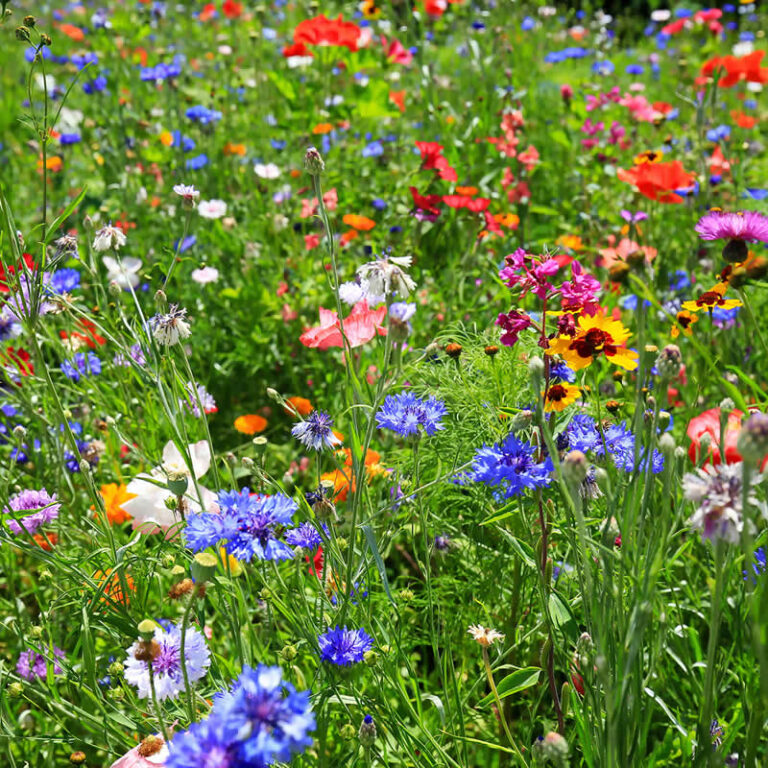Spring in the Air – The Best Times to Sow Wildflower Seeds
As the days grow longer and the weather warms up, it’s hard not to get excited about spring. There are all sorts of things to look forward to in the coming season, but one of our favourite parts is watching the wildflowers bloom. If you’re looking to get a head start on the season, we’ve got some good news: you can sow wildflower seeds now!
When Is the Best Time to Sow Wildflower Seeds
The best time to sow wildflower seeds will depend on the type of wildflower species, and your climate zone. Generally, early spring and early autumn are the best time to sow most wildflower seeds.
But there are a few things you need to take into account before you get started.
First, make sure to prepare the ground properly before you sow your seeds. Wildflowers need loose, well-drained soil to grow well. Clay soil can be problematic, as it can be difficult for the plant’s roots to penetrate. If your soil is heavy, mix in some compost or other organic matter to help improve drainage and aeration, and choose a seed mix suitable for clay and heavy soils.
Second, take a look at your climate zone to determine the best time to plant your seeds. In colder climates, wait until the last frost has passed before sowing your seeds. In warmer climates, it’s best to wait until late summer or early autumn so that the seeds have time to germinate before the first cold weather arrives.
Which Seeds Are the Best for Your Wildflower Meadow?
Now that you know when to sow your wildflower seeds, the next question is: which kind should you sow?
There are a dizzying array of options available on the market, but some of the most popular mixes contain varieties including oxeye daisies, cornflowers, poppies, corn marigolds, yellow rattle, bugle, ragged robin, and knapweed. Some of these seeds can be direct-sown into the ground, while others need to be started in pots and then transplanted.
Most seed packets will come with instructions on how to sow them, but if you’re not sure, get in touch with us and we will be more than happy to help.
Tips on How to Prepare the Ground for Wildflowers
To sow wildflower seeds effectively, you need to prepare the ground first. This means loosening the soil and removing any weeds or debris.
Wildflowers typically prefer soils with low nutrient levels, but sometimes it may be beneficial to add a small amount of organic matter like compost or manure to the soil to help improve its structure and fertility.
If you’re sowing in a garden bed, make sure the bed is at least six inches deep. If you’re planting in a container, use a soil mix that’s specifically designed for containers.
Once you’ve prepared the ground, it’s time to sow the seeds! Wildflowers can be sown at any time of year, but some times of year are better than others. The best times to sow wildflower seeds are early spring, late spring, or autumn.
Top Tips for Sowing Wildflower Seeds Successfully
To give your wildflower seeds the best chance for success, make sure to prepare the ground properly before sowing. And if you’re using previously harvested seed, give it a momentary soak in a container of lukewarm water to soften the seed coat.
Once you have your seed ready, sow them in well-draining soil and poor surface conditions. Doing so will help create a better contact between the seed and the soil. This can be achieved by mixing into sandy or gravelly soils or mixing with up to 50% compost or humus gently into prepared soil.
Also, it’s important to remember that wildflower seeds are lightweight and should be thinly scattered across the soil surface to ensure even coverage you don’t want large concentrations of seeds in one spot as they may not get enough light or moisture! Finally, make sure to water your plants regularly until they are established and find an appropriate location for them away from direct sunlight and windy conditions.
Once your wildflower seeds are planted, you may want to add a layer of mulch over the surface of the soil to retain moisture and protect against weeds. However, it’s best to wait until the seeds begin to sprout before applying this layer of mulch.

You can also protect your seeds from the worst of the cold weather and frost by covering them with a fleece layer. This should help your seeds to germinate and grow.
No matter your location, it’s best to sow wildflower seeds in the springtime. This will help ensure they have enough moisture to germinate and give you the best chance of seeing some beautiful blooms at the end of the season. Make sure to follow these top tips for sowing wildflower seeds and you’ll have a colorful and wild garden in no time!
What to Do After You’ve Sown the Seeds
Now that you’ve sown the seeds, the next step is to water the seed bed. Make sure you water the area evenly – a gentle spray is best, as you don’t want to displace the seeds or damage them with too much pressure.
You should add a layer of mulch over your seeds to help keep the soil moist and encourage new growth. This will also help to protect your wildflowers from wind, animals, and disease.
Make sure you check on your wildflower patch often and watch for signs of any pests or diseases that may have taken hold. And remember – if any weeds start popping up in your patch, be sure to pull them out before they can take over!
FAQs About Wildflower Seed Sowing
Are you looking for answers to some frequently asked questions about wildflower seed sowing? We’ve compiled some of the most commonly asked questions below – have a read and get informed!
Q: What ground preparation do I need to do when sowing wildflower seeds?
A: Before sowing your wildflower seeds, you’ll need to ensure the soil is free from weeds and other vegetation. This can be done by either hand-pulling or using a chemical weed killer. Make sure the soil is also well drained and moisture retentive so that you can avoid waterlogging and allow the root systems to establish well.
Q: When is the best time of year to sow wildflower seeds?
A: The best time of year to sow your wildflower seeds is during early spring, or early autumn when the ground temperature starts to rise slightly and days are starting to get longer. This will give your new plants plenty of time before winter sets in, so they can establish strong roots that will help them survive over colder months.
Wildahome – Growing and Sowing Wildflower Seeds
The bottom line is that, as long as you’re mindful of the climate and growing conditions in your area, you can sow wildflower seeds at any time of year. Just be sure to do your homework and prepare the ground accordingly, and you’ll be well on your way to creating a beautiful wildflower meadow in no time!
Wildahome can offer advice and support on preparing the ground and selecting the correct time of seed for your ground type and location. We have specific seeds harvested from meadows in counties around the UK.
We also offer a seed soil improver and mulch mat system for better germination.


